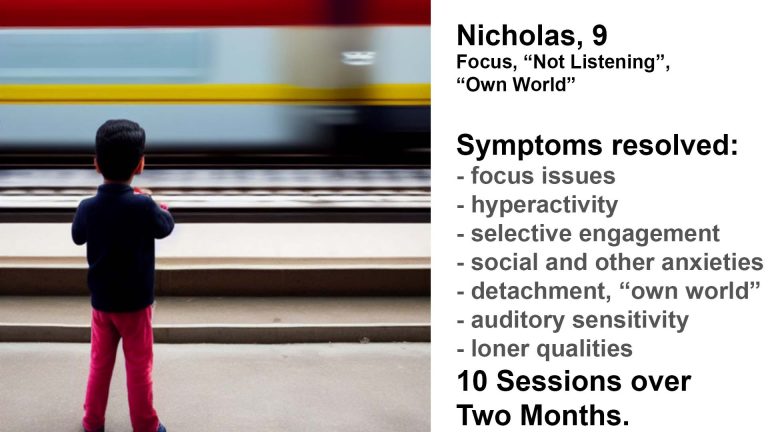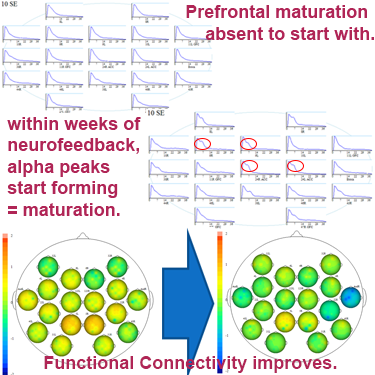Case Study: Nicholas, 9, ADHD, "Not Listening", "Own World"

Disengagement, Anxieties and Focus Issues resolved in Ten Sessions.
Before
– focus issues
– hyperactivity, could not sit still in class and with tutors
– selective engagement with outside world, “not listening”
– rebellious behaviour, particularly regarding authority (and tutors)
– detachment, reverting into own ‘fantasy’ world
– auditory hypersensitivity, overinterpreting emotional content of words
– social anxiety, not understanding social emotions
– lack of feeling part of group
– ineffective engagement with peers, loner qualities
– mood control and motivation issues
– inconsistent sleep
Ten sessions, over two months
After
– able to focus on movies and sit still during two hour sessions
– calm, attentive, “listening”
– rationally reactive, responding to instructions
– engaging with tutors and in classroom
– generally more ‘present’, less distracted by own imagination
– various anxiety markers remedied
– sincere engagement with peers, joining new activity groups
– substantial sleep improvement
– overall greater sense of positive engagement, motivation, being part of something
Nicholas' Full Story:
Nicholas is a highly intelligent nine year old with incredible creativity and perception. His school grades were not reflective of his aptitude, and his behaviour of concern to both his parents as well as the school and his private tutors. An elder sibling had just undergone a lengthier course of neurofeedback treatment that transformed him from being a developmentally delayed school-refuser into a social teenager passing his GCSEs, and his parents were keen to try neurofeedback with Nicholas.
With a brain map, we discovered, or in part, confirmed, the following challenges. Note that this does not form diagnosis, a separate avenue his parents were exploring due to suspected ‘ADHD’, and it also did not involve an invasive questioning ordeal typical of psychoanalysis.
– spatial distractibility
– immature perception of social complexities, emotions and boundaries
– tendency to generate fantastical internal content
– perceived underappreciation by his environment
– not feeling part of something bigger, or being included
– auditory hypersensitivity, ‘feeling judged’, how things are said
– motor strip dysrhythmia, manifesting in hyperactivity and coordination issues
– impulsive aggression in the face of unexpected outcomes
– inability to self-soothe, and thus mood control and motivation issues
– overanalysing consequences of actions, shyness, apprehensiveness
– excessive tendency to feeling shame, guilt
– immature understanding of social rules
– underdeveloped sense of self
– loner tendencies
– ‘what’s next’ anxiety
– sleep issues / lack of recuperative sleep
– prefrontal maturation behind peers
– inability to deal with uncertainty.
Some of these findings seemed counter-intuitive at first; Nicholas was popular with his peers, invited to all birthday parties, and while often introverted, he had a rebellious streak that had his tutors threatening to disengage. His parents attributed Nicholas’ tendencies to go into his own fantasy world as being part of childhood, though they did suspect that he wasn’t engaging with his ‘friends’ fully and rather seen as quirky and thus acceptable. What transpired was that Nicholas was living in a state of fear and anxiety, not realising his full social, and academic potential, nor a healthy sense of self. In parallel to the medical route of seeking an ADHD assessment, we started weekly neurofeedback sessions.
His parents’ initial concern was that Nicholas would not be able to handle a two-hour neurofeedback session. In their experience, he could not sit still for more than twenty minutes, which limited his time with tutors, while challenging their patience with rebellious and defiant behaviour. He had a good sense of humour and knew how to wind them up, to the extent that his tutors threatened to leave their mandate.
When Nicholas proudly arrived for his first neurofeedback session in the living room of his home – an off-bound areas for the children – he was dressed in a Superman outfit and brought a collection of his favourite action figures and model cars. His enthusiasm and curiosity was rewarded with a movie of his choice, and we found a seating arrangement that allowed him to change positions without losing sight of the screen, while permitting changes of electrode placements. He was soon engrossed in the content, and while he did change seating positions a number of times, we only had to interrupt the session once for him to change outfits, as Superman was less fitting and overheating. Nicholas was focussed on the movie and enjoyed his first two-hour session.
Nicholas’ parents were surprised and happy. They had not realised his ability to focus when he got his mind to it. Soon, this ability began to translate into his school behaviour, and an ADHD diagnosis after session five came back negative, to their elation.
In general, he began to appear more settled, confident and purposeful. Anxieties ceded, his patience improved as did his reactions to unexpected outcomes. This was especially noticeably with regard to his behaviour with his younger siblings, which had been fraught with petty arguments before. He seemed more mature, able to forgive and seek alternative actions, and generally appeared more present and engaged. His tutors began noticing substantial changes to their delight, and his academic performance reflected this.

Sleep noticably improved. He appeared more alert, confident, and well-rested. A remap after ten sessions showed this, and strong improvements on all challenges listed above; importantly, his prefrontal maturation metrics changed substantially, marking an acceleration in maturity.
Focus and anxiety seemed to be the main issues his parents were looking to address, afraid that he “be ADHD”, or “have” the ‘condition’, and some of his behaviour patterns appeared to fit the listed diagnostic criteria. This would expose him to a subjective assessment, potential lifetime label, and likely stimulant medication at a stage where his brain is still in a formative stage. His older sibling had endured this since age 10, and by age 15 was having panic attacks, experiencing developmental delays, and becoming a school refuser – a state we successfully remedied within a few months of neurofeedback training. As such, we were able to swerve such potential adverse developments.
More concerning however was the tendency to become absorbed in his own fantasy world, for which there were neural correlates that we detected on his brain map. A family history of mental health issues along these lines compounded this fear. This behaviour could still be attributed to being a young, bright and creative boy, and thus not addressed, missing an important junction in his development trajectory into teenage years, where the phenomenon would be far more worrying. Instead, we were able to establish a grounded sense of self that serves as a basis for constructive, meaningful social interaction by which Nicholas is able to grow and unfold his character in a pro-social manner, sharing his reality with others.
This case demonstrates the more granular nature of looking at personality development by means of a brain map, rather than using the existing boxes created by psychoanalysts. We can also make transformative changes in a short time, in an enjoyable, non-invasive manner.